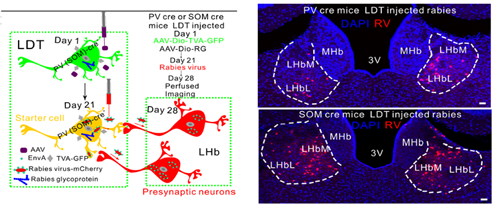Recently, Prof. Fuqiang Xu’s group at Wuhan Institute of Physics and Mathematics, CAS, collaborated with the team of Prof. Shumin Duan and Hao Wang from Institution of Neuroscience, Zhejiang University discovered new neural circuitry mechanisms for innate fear, and the experimental achievements have been published in Nature Neuroscience on January 4th, 2016. (http://www.nature.com/neuro/journal/vaop/ncurrent/full/nn.4208.html#figures)
Combined using optogenetics, behavioral assays and retrograde rabies virus tracing techniques, they found that projection from the lateral habenula (LHb) to the laterodorsal tegmentum (LDT) plays a key role in the olfactory cue-induced innate fear in mice. Furthermore, we found two interneuron subtypes (PV+ and SOM+) antagonistically regulated fear responses. Selective stimulation of PV-positive interneurons induced fear-like responses, whereas stimulation of SOM-positive interneurons or inhibition of PV neurons in the LDT suppressed TMT-induced fear-like responses.
In this study, Prof. Fuqiang Xu’s group were mainly responsible for dissecting the neuronal circuitry underlying innate fear by retrograde tracing with rabies virus . They injected AAV-CAG-Dio-TVA-GFP and AAV-CAG-Dio-RG and RV-EvnA-DsRed successively into the LDT of PV-cre and SOM-cre mice, and found that retrogradely-labeled neurons in the bilateral LHb of both PV-cre and SOM-cre mice, indicating that both interneuron subtypes in the LDT receive monosynaptic bilateral inputs from the LHb. Notablely, they found that a large population of local SOM+ interneurons in the LDT was retrogradely labeled in PV-cre mice and the same situation was observed for PV+ cells which were also retrogradely labeled in SOM-cre mice, which is exactly the neural circuitry basis for the opposite regulatory role of these two different types of neurons in the olfactory cue-induced innate fear in mice.
This study was supported by grants from the National Natural Science Foundation of China and the Chinese Academy of Sciences. Neural circuit tracing with neurotropic virus tools is a new direction in the field of neurobiology in recent years, it is also an important part of the "Brain Project" in United States, Europe, Japan and China. It has great prospects in the study of neural network structure, neural information encoding mechanisms and pathogenesis of some neuropsychiatric disorders.

Schematic diagram of retrograde tracing of the input neurons to LDT in SOM-cre or PV-cre mice (Left), both interneuron subtypes in LDT received bilateral LHb projections (Right).